 Kleiner Perkins Caufield & Byers is one of the firms sprinting to grow its cleantech practice — keeping up with Bay Area competitors like Khosla Ventures and CMEA Capital. To do so, it’s diversifying its interests in the sector and reaching deeper into individual verticals like the smart grid, carbon accounting, and biofuels. Today, it extended its solar strategy, joining a $63 million round of funding from Enphase Energy, one of the best-known makers of solar panel microinverters.
Kleiner Perkins Caufield & Byers is one of the firms sprinting to grow its cleantech practice — keeping up with Bay Area competitors like Khosla Ventures and CMEA Capital. To do so, it’s diversifying its interests in the sector and reaching deeper into individual verticals like the smart grid, carbon accounting, and biofuels. Today, it extended its solar strategy, joining a $63 million round of funding from Enphase Energy, one of the best-known makers of solar panel microinverters.
Granted, the word “microinverter” sounds far from sexy, but this type of technology has the potential to dramatically increase solar panel efficiency why simultaneously lowering costs — a big step toward making solar competitive with natural gas and coal. Companies like Enphase could very well by the industry’s lynchpin. That fact has obviously not escaped Kleiner, which has a reputation for king-making in the green space (think fuel cell maker Bloom Energy and plug-in car maker Fisker Automotive).
The core purpose of Enphase’s microinverters is actually very simple: they transform the direct current (DC) energy generated by solar panels into the alternative current (AC) energy that is used and channeled by electrical grids. They do this for each individual panel — which is actually a paradigm shift in solar architecture.
It used to be that just one of these devices would be hooked up to a series of panels in parallel. But solar power producers soon discovered that in this setup, if one panel is underperforming, it will drag down the output and efficiency of all the other panels in the same array. Attaching a microinverter to every individual panel isolates damaged, shaded or weak panels, allowing the rest to continue generating energy at top speed. The device also informs array operators of problems, allowing them to repair or replace panels that aren’t pulling their weight.
June 5th: The AI Audit in NYC
Join us next week in NYC to engage with top executive leaders, delving into strategies for auditing AI models to ensure fairness, optimal performance, and ethical compliance across diverse organizations. Secure your attendance for this exclusive invite-only event.
Today, Enphase’s primary customers are solar installers. It works with close to 900 across North America, according to co-founder and vice president of marketing Raghu Belur. In the last year, it released a new version of its microinverter software, allowing for a variety of applications (including allowing solar operators to monitor the status of panels from their smartphones). As it stands, Enphase’s technology is capable of increasing solar array energy output by 5 to 25 percent, Belur says.
The company’s microinverters are compatible with about 80 percent of solar modules currently on the market. In the past, Belur has been vocal about wanting to bundle Enphase’s devices with solar modules being sold to installers. This strategy hasn’t been fully realized, but the new funding should help with this.
The other major use for the capital will be to expand globally, the company says. Right now, it is active only in the U.S. and Canada, but this is soon to change.
“We are looking at expanding into Europe,” Belur tells VentureBeat. “We are not quite ready to announce a country at this time, but it’s easy to guess which ones.” Based on the information he provided, fair guesses would include Germany and Spain, the two top producers of solar equipment on the continent.
Founded just four years ago, the Petaluma, Calif.-based company is backed by Third Point Ventures, RockPort Capital Partners, Madrone Capital Partners, PCG Asset Management and Applied Ventures, and Bay Partners. And now, of course, Kleiner Perkins, which will no doubt increase the company’s visibility among major solar producers and installers, and give it a leg up on competitors like SolarBridge.
